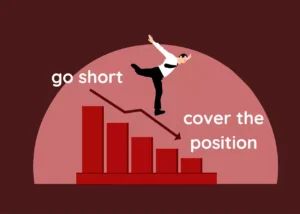It is easy for beginner traders to get lost when listening to conversations by seasoned traders. Trading involves lots of technical terms and specific jargon. For example, what does it mean to be “long” or “short” in a stock or option? This comes down to the following dichotomy: long position vs short position. In a nutshell, a long position suggests ownership of an asset whereas a short position implies short-selling the asset. The former can be associated with a bullish view whereas the latter with a bearish view. In the rest of this lesson, we discuss the distinction between these two types of positions in further detail.
Contents
What is a long position in stocks?

A long position in a stock (or going long on a stock) means that you have purchased (or purchasing) the shares of the stock. In other words, you have invested (or planning to invest) in the stock.
Going long on a stock implies a cash outflow from your perspective as you need to pay for the shares you are purchasing. Once you establish a long position, you are entitled to both cash-flow rights and voting rights of the shares you own. For example, you might receive dividends in regular intervals and benefit (or lose) from an increase (decrease) in the share price. You can also vote in matters related to the company’s management. Your exact voting rights would depend on the type of shares you own.
When you have a long position in a stock, you have unlimited upside potential. This means that there is no cap on the maximum return that you can earn from this investment. If the share price keeps rising, your return will keep increasing as well. In contrast, your downside potential is limited to −100%. In other words, you could lose all the money you invested in a stock if the share price goes down to zero, but you won’t be losing more than that due to limited liability.
What does it mean to cover a short position?

When you short sell shares of a stock, you are said to hold a short position in that stock. In such a case, you actually borrow the shares from another investor (e.g., through your broker) to sell them in the market. You’d normally establish a short position if you expect the share price to fall.
Covering a short position means closing out your position by buying back the shares from the market and returning them to the original owner. You’d make a profit out of this if you manage to buy shares back at a price lower than the one you (short) sold them for in the first place.
Going short on a stock implies a cash inflow from your perspective as you receive the cash generated from the sale. While you’re maintaining a short position, you are obliged to compensate the original investor for any dividends paid on the stock, though.
Sometimes, a short position can be used to finance a long position. For example, you can raise proceeds by short-selling shares of stock A. Then, you can use those proceeds to purchase shares of stock B. In such a scenario, you would hope that the share price of A would go down and that of B would go up. In general, long positions and short positions are combined to exploit arbitrage opportunities.
Short positions are considered to be risky because of their unlimited downside potential. This means that there is no cap on the maximum loss you’d incur if the stock that you shorted keeps increasing in value (against your expectations).
Video summary
Summary
Long position vs short position? The distinction between the two can be difficult to grasp for those who are new to trading. As we have explained in this lesson, a long position is established by purchasing an asset with the hope that its value will increase over time. Conversely, traders would take a short position in a stock if they expected the share price to go down. Table 1 below summarizes the differences between these two types of positions.
| Position type | View | Opening | Closing |
| Long position | The value will increase | Cash outflow | Profit/loss if sold at a higher/lower value |
| Short position | The value will decrease | Cash inflow | Profit/loss if bought back at a lower/higher value |
Further reading:
Dechow et al. (2001), “Short-sellers, fundamental analysis, and stock returns“, Journal of Financial Economics, Vol. 61(1), pp. 77-106.
What is next?
This lesson is part of our course on the fundamentals of trading.
- Next lesson: We will teach the key aspects of a limit order book.
- Previous lesson: We discussed the distinction between market orders and limit orders.
If you enjoyed reading this post, please consider spreading the word by sharing it on social media. Also, feel free to let us know if you have any comments about the post. You can write to us here.

